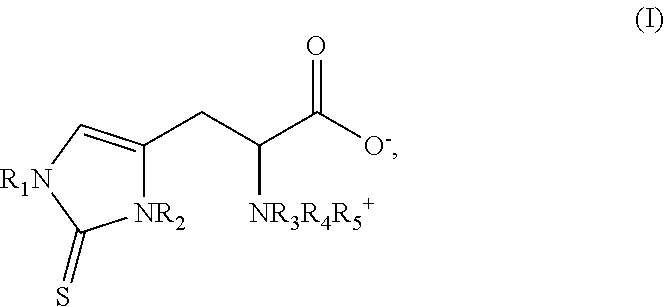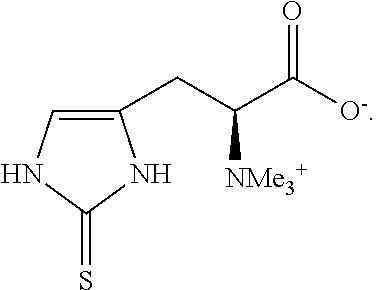The method of synthesizing ergothioneine and analogs
- Summary
- Abstract
- Description
- Claims
- Application Information
AI Technical Summary
Benefits of technology
Problems solved by technology
Method used
Image
Examples
example 1
Preparation of 2-{2-[(2-ammonio-2-carboxyethyl)thio]-1H-imidazol-4-yl}-1-carboxy-N,N,N-trimethylethanaminium dihydrochloride (Herc-Cys, 2HC1)
[0061]
[0062]986 mg (5 mmoles) of Hercynine (V. N. Reinhold et al., J. Med. Chem. 11, 258 (1968)) are dissolved in 10 mL of water. 417 μL (5 mmoles) of concentrated hydrochloric acid is added, then the solution is cooled to 0° C. Under very strong stirring, 308 μL (959 mg, 6 mmoles, 1.2 equiv.) of dibromine are added drop by drop (addition time 1 min 20). The reaction mixture turns yellow and a reddish solid is formed. Five minutes after the end of the addition of the dibromine, 1.87 g (15 mmoles, 3 equiv.) of L-Cysteine are added. Immediately, the mixture loses its colour, and the reddish precipitate dissolves in several minutes.
[0063]After stirring at 0° C. for 1 h, the mixture is filtered, and the precipitate washed with 2×0.5 mL of water. The filtrate is deposited on a column filled with 75 g of DOWEX® 50WX2-400, conditioned beforehand with ...
example 2
Preparation of 2-{2-[(2-ammonio-2-carboxyethyl)thio]-1H-imidazol-4-yl}-1-carboxy-N,N,N-trimethylethanaminium dichloride dihydrochloride (Herc-Cys, 2HC1)—variation of the quantity of L-Cysteine
[0066]
[0067]The same method as described in Example 1 is used, except that 3.12 g (25 mmoles, 5 equiv.) of L-Cysteine are added, seven minutes after the end of the addition of dibromine. After treatment and purification on a DOWEX® column, 1.13 g (58%) of the desired product are obtained after drying in the form of yellow crystals. The 1H-NMR (D2O / DC1) analysis is identical to that described in Example 1.
2—Preparation of Compounds of Formula (I) According to the Invention from Intermediates of Formula (II)
example 3
Preparation of L-Ergothioneine by Cleavage of Herc-Cys, 2HC1
[0068]
[0069]1.67 g (4.4 mmoles) of Herc-Cys, 2HC1 are solubilised in 16.7 mL of water, and 1.895 mL (2.29 g, 21.39 mmoles, 5 equiv.) of 3-mercaptopropionic acid are added. The clear, slightly yellow mixture is heated under stirring for 24 h at 85° C. Then 1.895 mL (2.29 g, 21.39 mmoles, 5 equiv.) of 3-mercaptopropionic acid is again added, and the heating is continued for 48 h.
[0070]The reaction mixture is cooled to 0° C., and a white precipitate forms. After filtration and rinsing of the precipitate with 2×2 mL of cold water, the filtrate is washed with 5×20 mL of dichloromethane and 5×20 mL of ethyl acetate.
[0071]The aqueous phase is evaporated under vacuum, and the residue dissolved in 33 mL of water. By addition of a 20% ammonia solution, the pH of the solution is adjusted to 6. After lyophilisation, the powder obtained is hot solubilised in an ethanol / water mixture (7 / 1). After addition of activated charcoal (100 mg) a...
PUM
 Login to View More
Login to View More Abstract
Description
Claims
Application Information
 Login to View More
Login to View More - R&D
- Intellectual Property
- Life Sciences
- Materials
- Tech Scout
- Unparalleled Data Quality
- Higher Quality Content
- 60% Fewer Hallucinations
Browse by: Latest US Patents, China's latest patents, Technical Efficacy Thesaurus, Application Domain, Technology Topic, Popular Technical Reports.
© 2025 PatSnap. All rights reserved.Legal|Privacy policy|Modern Slavery Act Transparency Statement|Sitemap|About US| Contact US: help@patsnap.com



